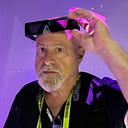Light Field Lab’s New Naked-Eye Holograms
I just saw my first true hologram. I was visiting Light Field Lab, a Silicon Valley company which today unveiled its unique holographic system, SolidLight.™ No glasses are needed to see realistic holograms blended perfectly into the physical world. There was no glass or other hidden projection surface. The hologram is not preserved in a block of amber, like the ones found in tourist shops. This hologram of a gremlin seemed solid as the surface on which it sat. It’s even interactive. They told me to tickle its tummy, and it giggled.
Light Field Lab creates holograms with their directly emissive and modular SolidLight™ Surfaces, which are capable of forming dense converging wavefronts with billions of pixels at photonic resolution. SolidLight Surface walls feature 10 billion pixels per square meter. What this means is that objects can be projected from any SolidLight Surface ultimately including walls, floors, ceilings, and even tabletops. “Our mission,” co-founder and CEO Jon Karafin told me, “is to redefine visual communication by freeing us from a world consumed by flat images and transition back to the way we see the natural world by forming real objects mid-air.”

Light Field Lab’s proprietary WaveTracer™ hardware and software, in conjunction with multiple self-emissive bezel-less SolidLight Surface Panels, scale to accommodate a wide range of holographic entertainment, advertising, and commercial applications. The first market the company is addressing is the video wall market, which encompasses multiple verticals. Fortune business says LED Video Walls Market size was $15.91 Billion in 2018 and is projected to reach $36.16 Billion by 2026. The company says pre-production systems sold out immediately after the initial 2019 offering.

Light Field Lab was founded in 2017 by Lytro veterans Karafin, Brendan Bevensee, and Ed Ibe, who noted how limited the industry was by the lack of a true holographic display technology for its light field capture. “At the core of Light Field Lab’s SolidLight technology,” said Karafin, “is the nanoparticle polymer energy surface that forms the emissive SolidLight panel. This allows us to convert pixels into wavefronts that can control and focus light with real-time interactive software.” In 2019, Light Field Lab raised $35M from Khosla Ventures, Samsung Ventures, Verizon Ventures, Comcast, Liberty Global Ventures, Bosch Ventures (RBVC), Taiwania Capital, NTT DOCOMO Ventures, HELLA Ventures, AVG, R7 Partners, and ACME Capital. They’ve already internationally filed three hundred patents.

Anywhere there’s a video wall, there could be a hologram. Indeed, one of Light Field Lab’s first customers plans to deploy a massive SolidLight Surface wall in a very, very public place as soon as next year, creating public spectacle. SolidLight could bring distant colleagues, friends or relatives into the same room, creating true naked-eye holographic telepresence. SolidLight Surfaces could enable holographic table games.

There are competing systems that do similar things, but they do not make actual holograms, not like the ones I saw. The biggest offender is Microsoft, which named its AR head mounted display the HoloLens, and calls its illusions holograms. Kino-Mo’s HYPERVSN (sic) system at CES always draws a crowd with its floating images of burgers and sneakers, which are created by spinning LEDs they call “venue holograms, the future of in-store communication.” Looking Glass supplies autostereoscopic displays for designers and animators which they call a holographic display, and it is visible to the naked eye, but it plays inside of a box, not inside of a room.
Light Field Lab’s customers can build bespoke content for the system using game engines like Unreal Engine and Unity or other industry-standard content creation tools like Maya. The demonstration included a configurable and wide angle 100-degree field-of-view. Pricing varies depending on the size/range of application parameters and is competitive with the latest premium fine pitch video walls. As part of today’s announcement, Light Field Lab is now accepting applications to pre-order first production SolidLight systems due next year.
Follow me on Twitter or LinkedIn. Check out my website or some of my other work here.
Originally published at https://www.forbes.com.
